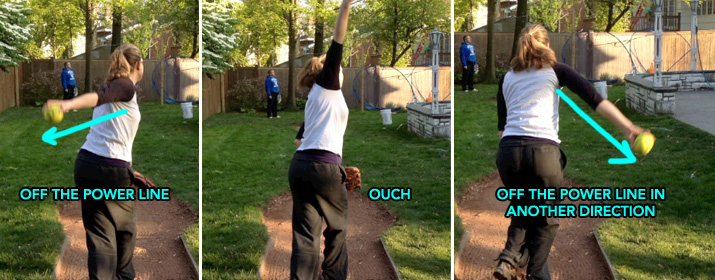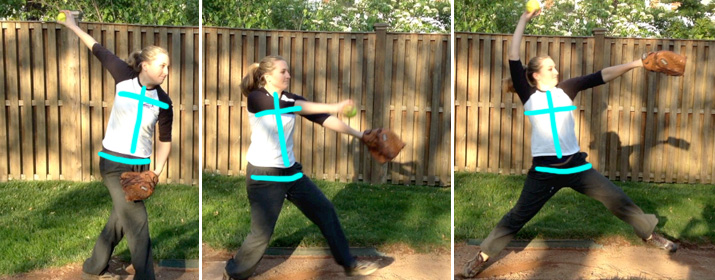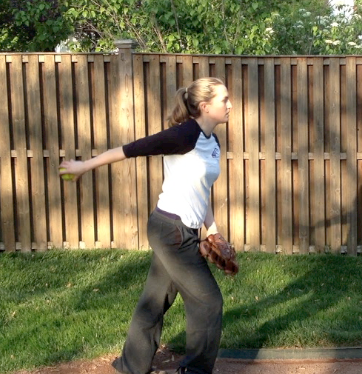Is Your Pre-motion Hurting Your Pitch? Part 3
We’re continuing our series on the pre-motion portion of the windmill pitch and the most common pre-motion issues that end up affecting the pitch negatively. Today’s topic might be a bit controversial: it’s the backswing. I’ll be honest; if it were up to us, we’d eliminate windmill pitchers’ backswings altogether. We believe they do more harm than good, and we’ll explain why in this post. That said, if you must have a backswing to pitch comfortably, you should definitely be aware of the problems that certain backswings can cause and how to keep them under control.
Why All Windmill Pitchers Should Reconsider Backswings
Let’s be clear: we are completely aware that A LOT of windmill pitchers, including a lot of elite and even famous pitchers, pitch with backswings very successfully. We are not remotely suggesting that you cannot pitch successfully if you have a backswing. However, we will argue that ANY pitcher, no matter how successful, has the potential to gain an additional edge if the backswing is eliminated.
Let’s assume that the pitcher in question has a good, relaxed backswing that does not cause any mechanical problems in the rest of the pitch. Our main beef with backswings in this case is ball visibility. Simply put, if you have a backwing of any size, especially if it’s a big one, the batter can see and track the ball for a long time. If your backswing is particularly big, you may even be flashing your grip to the third base coach (first base if you’re a lefty) who might then be able to relay that info to the batter via signs.
Even if you’re throwing the ball upwards of 60 mph and think you’d only gain a small edge from hiding the ball in your pre-motion, why wouldn’t you want any edge you could get, no matter how small? And if you’re one of the thousands of pitchers who top out in the mid to high 50s and rely on great movement and changing speeds, the edge you would gain by hiding the ball could potentially be quite significant.
If you’re interested in seeing for yourself, here’s a good test: set up a full length mirror so you can stand in front of it as if it’s your catcher. Put a ball in your hand and go through your motion with a backswing, watching carefully in the mirror. Count how many seconds the ball is visible until your release point. Then try again, keeping the ball hidden in your glove throughout the pre-motion. Count the seconds the ball is visible. If you imagine you’re the batter, which pitch do you think would be harder to hit, if the pitches were otherwise equal?
How to Optimize Your Backswing, If You Must
Now, if you’ve given it a proper try and you just absolutely cannot pitch as comfortably or effectively without a backswing, there are a few things you must consider to ensure that your backswing is not detrimental to the rest of your pitch. It must not take your arm off the power line, not affect your track, and not put unnecessary stress on your shoulder. Watch the following video, showing two examples of problem backswings in full speed and slow motion, followed by a good one. Then read on for further explanation:
Keeping Your Backswing on the Power Line
Many bad backswings are problematic because they are too free-flinging and out of control, taking the arm off the power line. Once the arm is off the power line and moving at a high speed, it can be difficult to find the line again, and the pitcher’s command can be negatively affected:

While it’s not impossible to get back on the power line with this type of back swing, it’s much more difficult than when the backswing is kept under control in the first place, especially for a young pitcher. Who needs pitching to be more difficult than it already is?
Keeping Your Body Facing Forward
Another problem that affects the vast majority of my students with backswings is allowing the upper body to turn with the momentum of the arm. This can affect the reach and ultimately the track:

As you can see in the picture, from the time of the backswing the body remains tracked. For optimal power, a fast and dynamic track should take place no earlier than the position shown in frame 3 of the above image. A premature track also frequently results in a premature forward rotation of the hips before the ball is delivered. Additionally, pitchers, especially young pitchers, who lack the core strength to consistently get back to a good forward reach after this type of back swing often end up reaching to the side (again, off the power line). This is happening in frame 2 of the above image, though the angle makes it somewhat difficult to see.
Preventing Shoulder Injury
If the other points I’ve made don’t convince you, please give this one some serious consideration. If you have a big backswing, perhaps like one demonstrated above, do this test: Take your backswing to its furthest point, then pause and hold it there as long as you can. How long before you start to get tired and feel stress in your shoulder? Not long I bet. I know you’re not holding your arm in that position when you pitch, but you are hitting that spot every single time. Think of how many pitches you throw in a game, in a week, or in a lifetime. Every time you throw a pitch, you’re putting your shoulder in that stressful position for a split second, and those split seconds can really add up. Is it possible nothing bad will come of it? Sure. But I know from experience what it’s like taking time off from something you love because of an injury. I wouldn’t want to take the risk.
What A Good Backswing Looks Like
If you must have a backswing, it should be small, controlled, on the power line, and independent of torso movement:

Notice how the upper body is still facing the catcher, and the angle on the arm is still downward, minimizing stress on the shoulder.
If you’d like to find your ideal backswing size, stand in front of a mirror again so you can see if you move your torso. Swing your arms gently back and forth as if you were walking briskly. If you’re not allowing your torso to turn along with your arms, you should feel a natural stopping point off of which your arms bounce before coming forward again. Your backswing should also stop at this natural point.
Recommended Non-Backswing Pre-Motions
Even if you get your backswing perfectly under control, we still recommend that you consider at least trying to eliminate it altogether. Here are some well known pitchers who do not have backswings. Take a look at their pre-motions and see if you can try one for yourself. (NOTE: only look at their pre-motions. Since you may not be able to tell what pitch they’re throwing, be wary of mimicking other parts of the pitch)
Michele Smith striking out John Kruk (pitching starts at about 44 sec. in)
As always, leave your questions in the comments!
I wanted to comment on why a backswing should be used, I feel like you get maximum arm speed, if you do it a certain way. I have tried every promotion with my daughter and her timing is just horrible with the others. Why? Because her arms are behind! She swings both her arms back and pitches very good like that. We found the key is to start with arms above your head and let the weight of arms take you to the backswing, she uses little to no energy. On the way back she gets a good weight transfer and her drive knee is well behind her toes which creates a good lean. she also waits until her arms swing back up and almost parallel to the ground before she pushes off. This is what creates the good timing!!!!! Timing is everything, and I think a lot of these pre motions make timing hard to get. I know some people will argue that the arms may lock out using this method to, but that is because they are muscling on the way down. Let gravity be your friend! I also see the argument that third base coach will sneak a peak at your grip and may yell out to the batter what she is throwing but I find that to be a distraction to the batter and welcome it. If they are listening to a coach they are not focused on the pitch. Also my daughter throws a lot of her pitches without changing grip, so hardly that helpful to a batter. The key to me is getting those arms started before the push and whatever works go with it and don’t change it when you find it, thanks for all your advice!!!!!!!!!! Your advice above is spot on about staying tight to the body with the backswing, and I say the key to that is keeping those arms loose , really hard to do if your trying to muscle that backswing.
Hi Ken, I’m glad the backswing is working for your daughter, and it sounds like she’s implementing it the right way. While backswings do cause problems for a lot of pitchers, the reverse is ALSO true; I have several who just can’t get their arms relaxed enough without it! In cases like that it should definitely be used.